Magnetic Field, Variable Thermal Conductivity, Thermal Radiation, and Viscous Dissipation Effect on Heat and Momentum of Fractional Oldroyd-B Bio Nano-Fluid within a Channel
Abstract
1. Introduction
2. Mathematical Formulation
- Flow is uni-directional, incompressible, and unsteady
- Neglecting the pressure gradient
- A permeable medium is considered
- Thermal conductivity is considered a variable
- Applying magnetic field (neglecting induced magnetic field)
- Viscous dissipation is significant.
3. Skin Friction and Nusselt Number
4. Numerical Procedure
5. Numerical Analysis and Discussion
6. Conclusions
- a
- The addition of a nanoparticle (copper) to the base fluid (blood) enhances the thermal conductivity of fractional Maxwell bio-nanofluid; this causes the temperature profile to decrease by the increase in volumetric fractional nanoparticles (Copper).
- b
- The temperature profile gains high value by increasing the values of the variable thermal conductivity constant
- c
- The thermal radiation parameter increases the heat transfer rate of the aforementioned physical problem.
- d
- The permeable medium decreases the velocity profile of the viscoelastic fractional bio-nanofluid.
- e
- There is an increase in the temperature profile observed by increasing the values of the viscous dissipation parameter Ec.
Author Contributions
Funding
Data Availability Statement
Acknowledgments
Conflicts of Interest
Nomenclature
| Physical Quantities | Symbol (Unit) |
| Velocity | u (m/s) |
| Temperature | (k) |
| Density of nanofluid | (kg/m3) |
| Gravitational acceleration | g (m/s2) |
| Heat capacity of nanofluid | (Cp)nf (JK−1) |
| Time relaxation parameter | (s) |
| Time retardation parameter | (s) |
| Extra stress tensor component | Sxy (Nm−2) |
| Prandtl number | Pr |
| Eckert number | Ec |
| Current density | J |
| Dynamic viscosity of nanofluid | µnf (kg/ms) |
| Thermal conductivity of nanofluid | knf (W/mK) |
| Volumetric expansion | βθ (K−1) |
| The electric conductivity of nanofluid | σnf (s/m) |
| Kinematic viscosity of nanofluid | νnf (m2/s) |
| Gharshof number | Gr |
| Applied magnetic field | M |
| Cauchy stress tensor | T |
| Porosity parameter | |
| Caputo fractional derivative | |
| Darcy resistance | R |
References
- Oldroyd, J.G. On the formulation of rheological equations of state. Proc. R. Soc. Lond. Ser. A Math. Phys. Sci. 1950, 200, 523–541. [Google Scholar] [CrossRef]
- Basha, H.T.; Sivaraj, R. Numerical simulation of blood nanofluid flow over three different geometries by means of gyrotactic microorganisms: Applications to the flow in a circulatory system. Proc. Inst. Mech. Eng. Part C J. Mech. Eng. Sci. 2020, 235, 441–460. [Google Scholar] [CrossRef]
- Nilsson, A.L. Blood Flow, Temperature, and Heat Loss of Skin Exposed to Local Radiative and Convective Cooling. J. Investig. Dermatol. 1987, 88, 586–593. [Google Scholar] [CrossRef] [PubMed]
- He, Y.; Liu, H.; Himeno, R.; Shirazaki, M. Numerical and experimental study on the relationship between blood circulation and peripheral temperature. J. Mech. Med. Biol. 2005, 5, 39–53. [Google Scholar] [CrossRef]
- Saqib, M.; Khan, I.; Shafie, S. Generalized magnetic blood flow in a cylindrical tube with magnetite dusty particles. J. Magn. Magn. Mater. 2019, 484, 490–496. [Google Scholar] [CrossRef]
- Ebaid, A.; Aljohani, A.F.; Aly, E.H. Homotopy perturbation method for peristaltic motion of gold-blood nanofluid with heat source. Int. J. Numer. Methods Heat Fluid Flow 2019, 30, 3121–3138. [Google Scholar] [CrossRef]
- Lin, W.-L.; Yen, J.-Y.; Chen, Y.-Y.; Jin, K.-W.; Shieh, M.-J. Relationship between acoustic aperture size and tumor conditions for external ultrasound hyperthermia. Med. Phys. 1999, 26, 818–824. [Google Scholar] [CrossRef]
- Misra, J.; Shit, G. Biomagnetic viscoelastic fluid flow over a stretching sheet. Appl. Math. Comput. 2009, 210, 350–361. [Google Scholar] [CrossRef]
- Choi, S.U.; Eastman, J.A. Enhancing Thermal Conductivity of Fluids with Nanoparticles; Argonne National Lab (ANL): Argonne, IL, USA, 1995. [Google Scholar]
- Sheremet, M.A.; Grosan, T.; Pop, I. Free Convection in a Square Cavity Filled with a Porous Medium Saturated by Nanofluid Using Tiwari and Das’ Nanofluid Model. Transp. Porous Media 2014, 106, 595–610. [Google Scholar] [CrossRef]
- Sheremet, M.; Pop, I.; Bachok, N. Effect of thermal dispersion on transient natural convection in a wavy-walled porous cavity filled with a nanofluid: Tiwari and Das’ nanofluid model. Int. J. Heat Mass Transf. 2016, 92, 1053–1060. [Google Scholar] [CrossRef]
- Wong, K.V.; De Leon, O. Applications of nanofluids: Current and future. Adv. Mech. Eng. 2017, 2, 105–132. [Google Scholar] [CrossRef]
- Chen, J.L.T.; Oumer, A.N.; Azizuddin, A. A review on thermo-physical properties of bio, non-bio and hybrid nanofluids. J. Mech. Eng. Sci. 2019, 13, 5875–5904. [Google Scholar] [CrossRef]
- Abo-Elkhair, R.; Bhatti, M.; Mekheimer, K.S. Magnetic force effects on peristaltic transport of hybrid bio-nanofluid (AuCu nanoparticles) with moderate Reynolds number: An expanding horizon. Int. Commun. Heat Mass Transf. 2021, 123, 105228. [Google Scholar] [CrossRef]
- Eid, M.R. Effects of NP Shapes on Non-Newtonian Bio-Nanofluid Flow in Suction/Blowing Process with Convective Condition: Sisko Model. J. Non-Equilib. Thermodyn. 2019, 45, 97–108. [Google Scholar] [CrossRef]
- Tanveer, M.; Ullah, S.; Shah, N.A. Thermal analysis of free convection flows of viscous carbon nanotubes nanofluids with generalized thermal transport: A Prabhakar fractional model. J. Therm. Anal. 2021, 144, 2327–2336. [Google Scholar] [CrossRef]
- Wang, F.; Asjad, M.I.; Zahid, M.; Iqbal, A.; Ahmad, H.; Alsulami, M.D. Unsteady thermal transport flow of Casson nanofluids with generalized Mittag–Leffler kernel of Prabhakar’s type. J. Mater. Res. Technol. 2021, 14, 1292–1300. [Google Scholar] [CrossRef]
- Asjad, M.I.; Basit, A.; Iqbal, A.; Shah, N.A. Advances in transport phenomena with nanoparticles and generalized thermal process for vertical plate. Phys. Scr. 2021, 96, 114001. [Google Scholar] [CrossRef]
- Chu, Y.M.; Ikram, M.D.; Imran, M.A.; Akgül, A. MHD Flow of a Newtonian Fluid in Symmetric Channel with ABC Fractional Model Containing Hybrid Nanoparticles. Comb. Chem. High Throughput Screen. 2022, 25, 1087–1102. [Google Scholar] [CrossRef]
- Khan, I.; Raza, A.; Shakir, M.A.; Al-Johani, A.S.; Pasha, A.A.; Irshad, K. Natural convection simulation of Prabhakar-like fractional Maxwellfluid flowing on inclined plane with generalized thermal flux. Case Stud. Therm. Eng. 2022, 102042. [Google Scholar] [CrossRef]
- Sun, Y.-L.; Shah, N.A.; Khan, Z.A.; Mahrous, Y.; Ahmad, B.; Chung, J.D.; Khan, M.N. Exact solutions for natural convection flows of generalized Brinkman type fluids: A Prabhakar-like fractional model with generalized thermal transport. Case Stud. Therm. Eng. 2021, 26, 101126. [Google Scholar] [CrossRef]
- Asjad, M. Fractional Mechanism with Power Law (Singular) and Exponential (Non-singular) Kernels and Its Applications in Bio Heat Transfer Model. Int. J. Heat Technol. 2019, 37, 846–852. [Google Scholar] [CrossRef]
- Anwar, T.; Kumam, P.; Asifa; Thounthong, P.; Muhammad, S.; Duraihem, F.Z. Generalized thermal investigation of unsteady MHD flow of Oldroyd-B fluid with slip effects and Newtonian heating; a Caputo-Fabrizio fractional model. Alex. Eng. J. 2021, 61, 2188–2202. [Google Scholar] [CrossRef]
- Wang, F.; Rehman, S.; Bouslimi, J.; Khaliq, H.; Qureshi, M.I.; Kamran, M.; Alharbi, A.N.; Ahmad, H.; Farooq, A. Comparative study of heat and mass transfer of generalized MHD Oldroyd-B bio-nano fluid in a permeable medium with ramped conditions. Sci. Rep. 2021, 11, 23454. [Google Scholar] [CrossRef] [PubMed]
- Wang, C.-C. Mathematical Principles of Mechanics and Electromagnetism: Part A: Analytical and Continuum Mechanics; Springer Science & Business Media: Berlin/Heidelberg, Germany, 2013; Volume 16. [Google Scholar]
- Fetecau, C. The first problem of Stokes for an Oldroyd-B fluid. Int. J. Non-Linear Mech. 2003, 38, 1539–1544. [Google Scholar] [CrossRef]
- Saqib, M.; Khan, I.; Chu, Y.-M.; Qushairi, A.; Shafie, S.; Nisar, K.S. Multiple Fractional Solutions for Magnetic Bio-Nanofluid Using Oldroyd-B Model in a Porous Medium with Ramped Wall Heating and Variable Velocity. Appl. Sci. 2020, 10, 3886. [Google Scholar] [CrossRef]
- Liu, Y.; Zheng, L.; Zhang, X. Unsteady MHD Couette flow of a generalized Oldroyd-B fluid with fractional derivative. Comput. Math. Appl. 2011, 61, 443–450. [Google Scholar] [CrossRef]
- Anwar, T.; Kumam, P.; Khan, I.; Watthayu, W. Heat Transfer Enhancement in Unsteady MHD Natural Convective Flow of CNTs Oldroyd-B Nanofluid under Ramped Wall Velocity and Ramped Wall Temperature. Entropy 2020, 22, 401. [Google Scholar] [CrossRef]
- Maripala, S.; Naikoti, K. Joule Heat Parameter Effects on Unsteady MHD flow Over a Stretching Sheet with Viscous Dissipation and Heat source. Appl. Appl. Math. Int. J. 2019, 14, 4. [Google Scholar]
- Aziz, A.; Shams, M. Entropy generation in MHD Maxwell nanofluid flow with variable thermal conductivity, thermal radiation, slip conditions, and heat source. AIP Adv. 2020, 10, 015038. [Google Scholar] [CrossRef]
- Raptis, A.; Perdikis, C.; Takhar, H. Effect of thermal radiation on MHD flow. Appl. Math. Comput. 2004, 153, 645–649. [Google Scholar] [CrossRef]
- Yusuf, T.A.; Mabood, F.; Khan, W.A.; Gbadeyan, J.A. Irreversibility analysis of Cu-TiO2-H2O hybrid-nanofluid impinging on a 3-D stretching sheet in a porous medium with nonlinear radiation: Darcy-Forchhiemer’s model. Alex. Eng. J. 2020, 59, 5247–5261. [Google Scholar] [CrossRef]
- Zhao, J.; Zheng, L.; Zhang, X.; Liu, F. Unsteady natural convection boundary layer heat transfer of fractional Maxwell viscoelastic fluid over a vertical plate. Int. J. Heat Mass Transf. 2016, 97, 760–766. [Google Scholar] [CrossRef]
- Khan, A.Q.; Rasheed, A. Mixed Convection Magnetohydrodynamics Flow of a Nanofluid with Heat Transfer: A Numerical Study. Math. Probl. Eng. 2019, 2019, 8129564. [Google Scholar] [CrossRef]
- Zhuang, P.; Liu, F. Implicit difference approximation for the time fractional diffusion equation. J. Appl. Math. Comput. 2006, 22, 87–99. [Google Scholar] [CrossRef]
- Usman, M.; Hamid, M.; Zubair, T.; Haq, R.U.; Wang, W. Cu-Al2O3/Water hybrid nanofluid through a permeable surface in the presence of nonlinear radiation and variable thermal conductivity via LSM. Int. J. Heat Mass Transf. 2018, 126, 1347–1356. [Google Scholar] [CrossRef]
- Sharma, K.; Gupta, S. Viscous Dissipation and Thermal Radiation effects in MHD flow of Jeffrey Nanofluid through Impermeable Surface with Heat Generation/Absorption. Nonlinear Eng. 2017, 6, 153–166. [Google Scholar] [CrossRef]
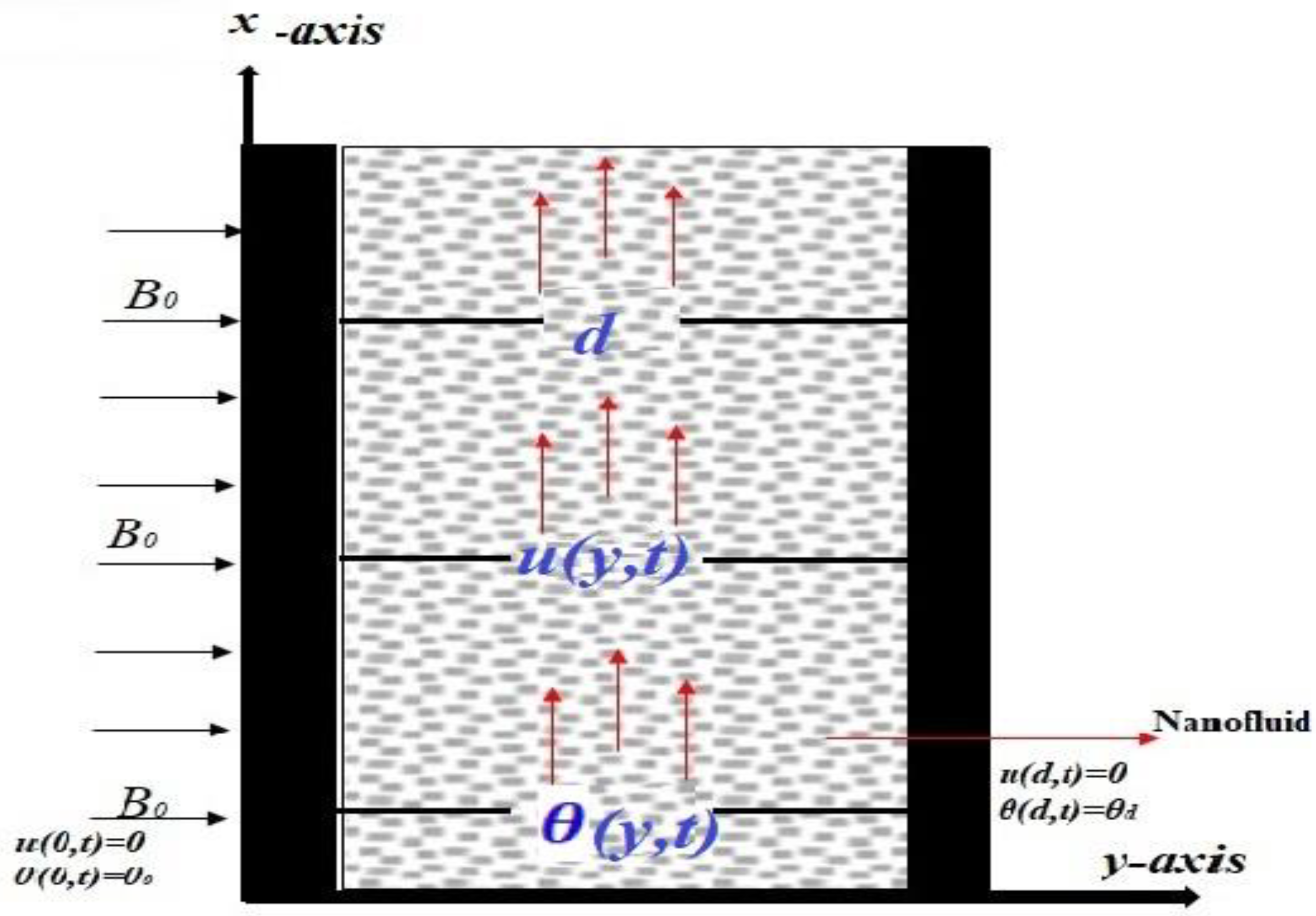

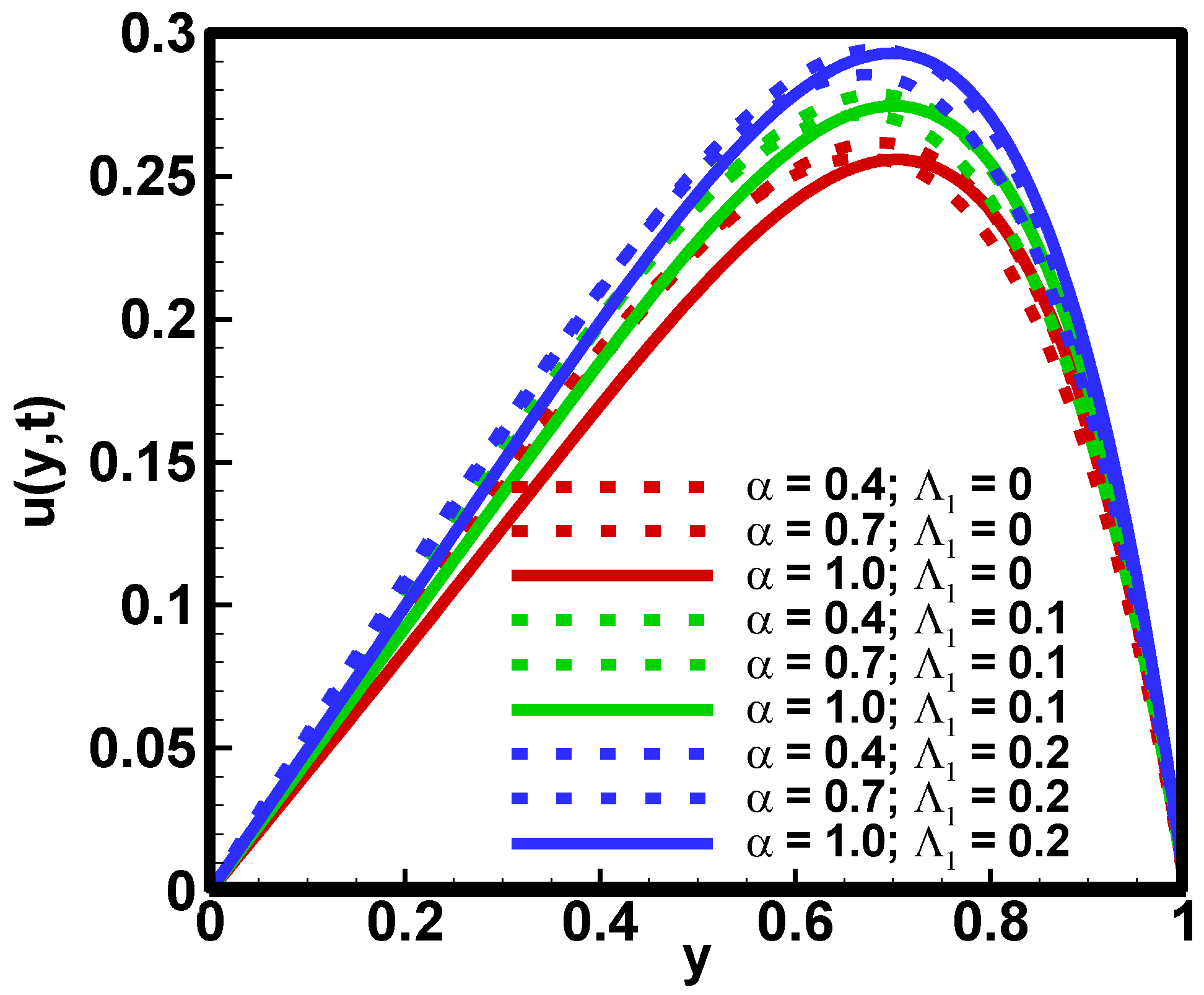
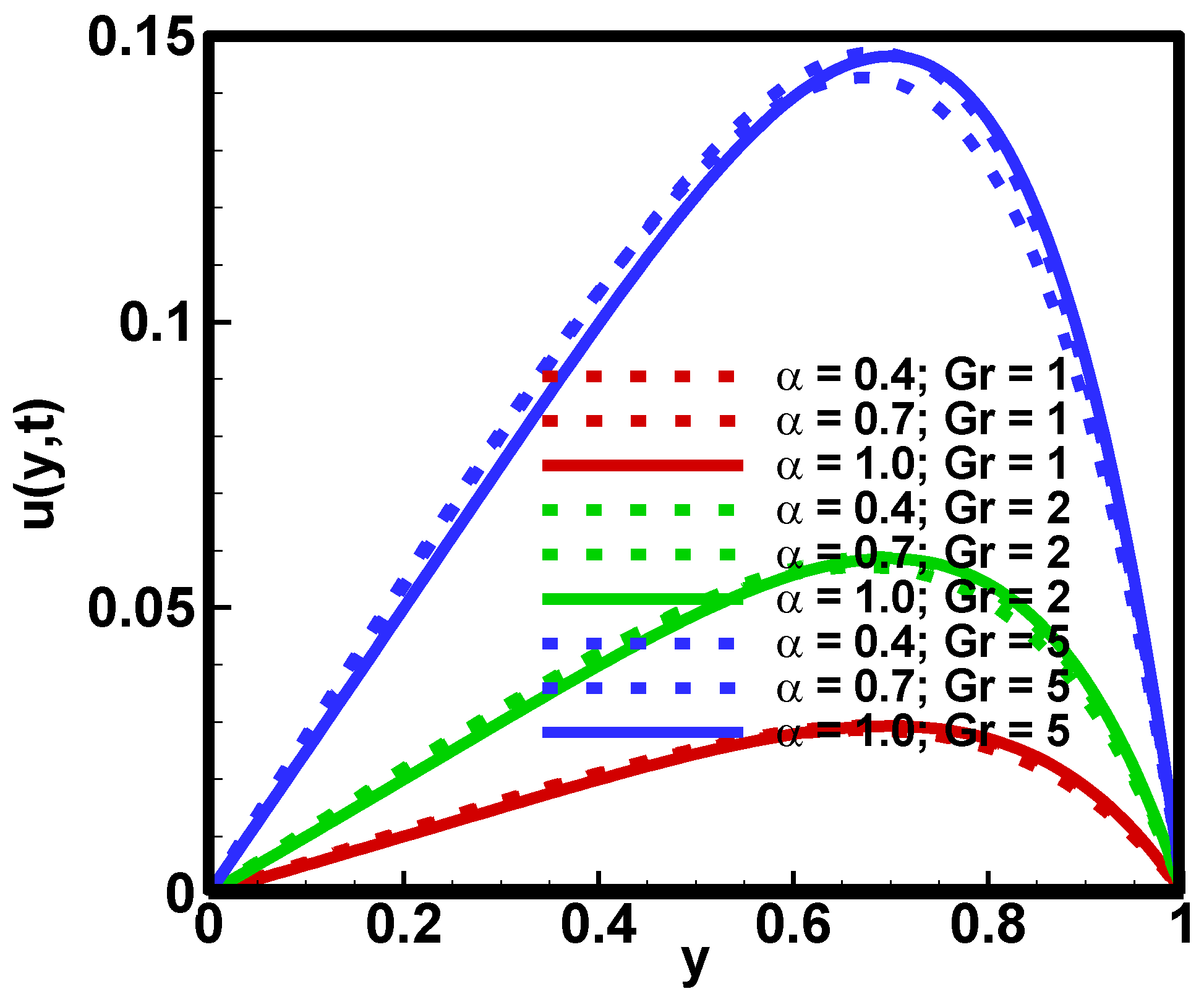
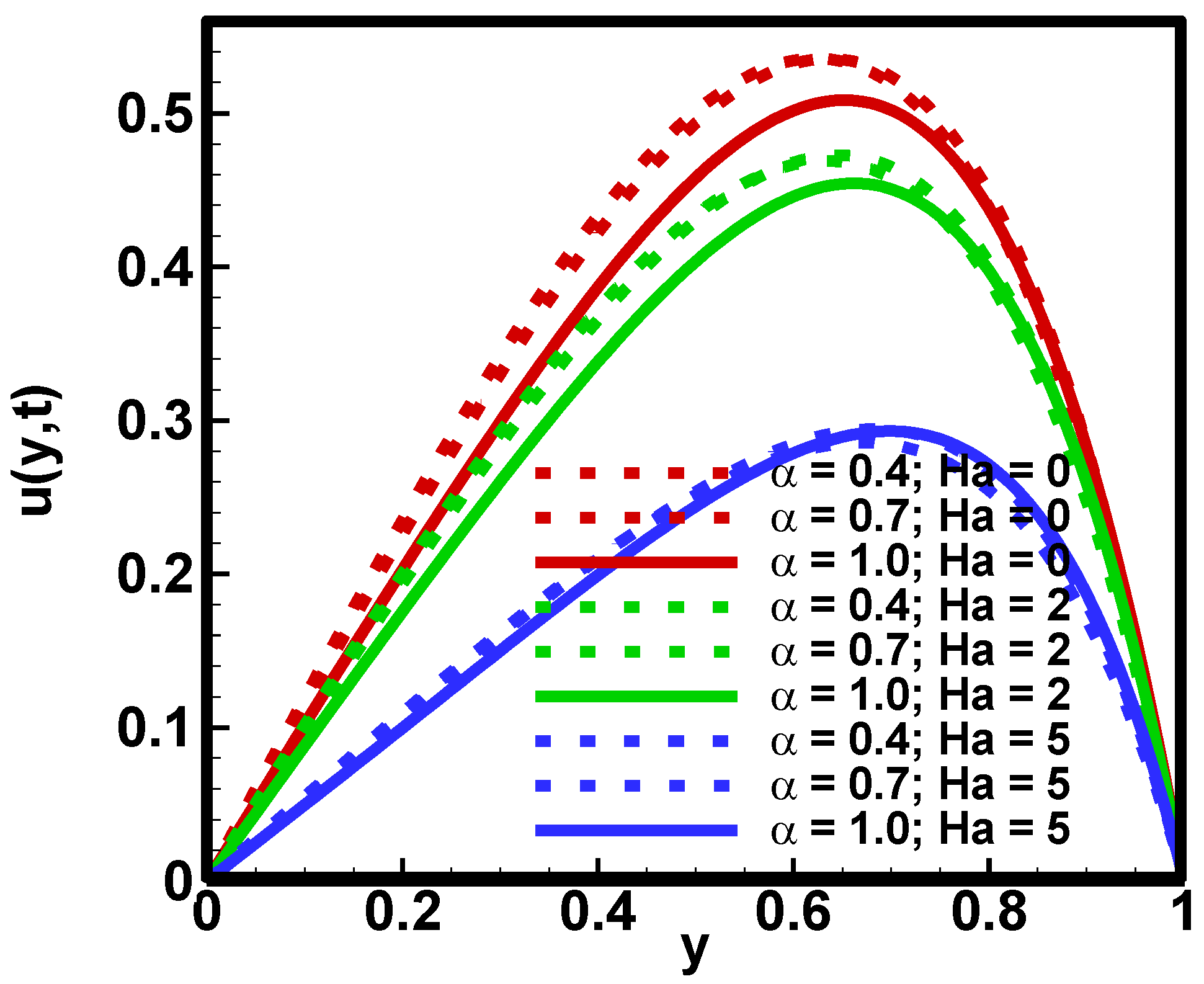
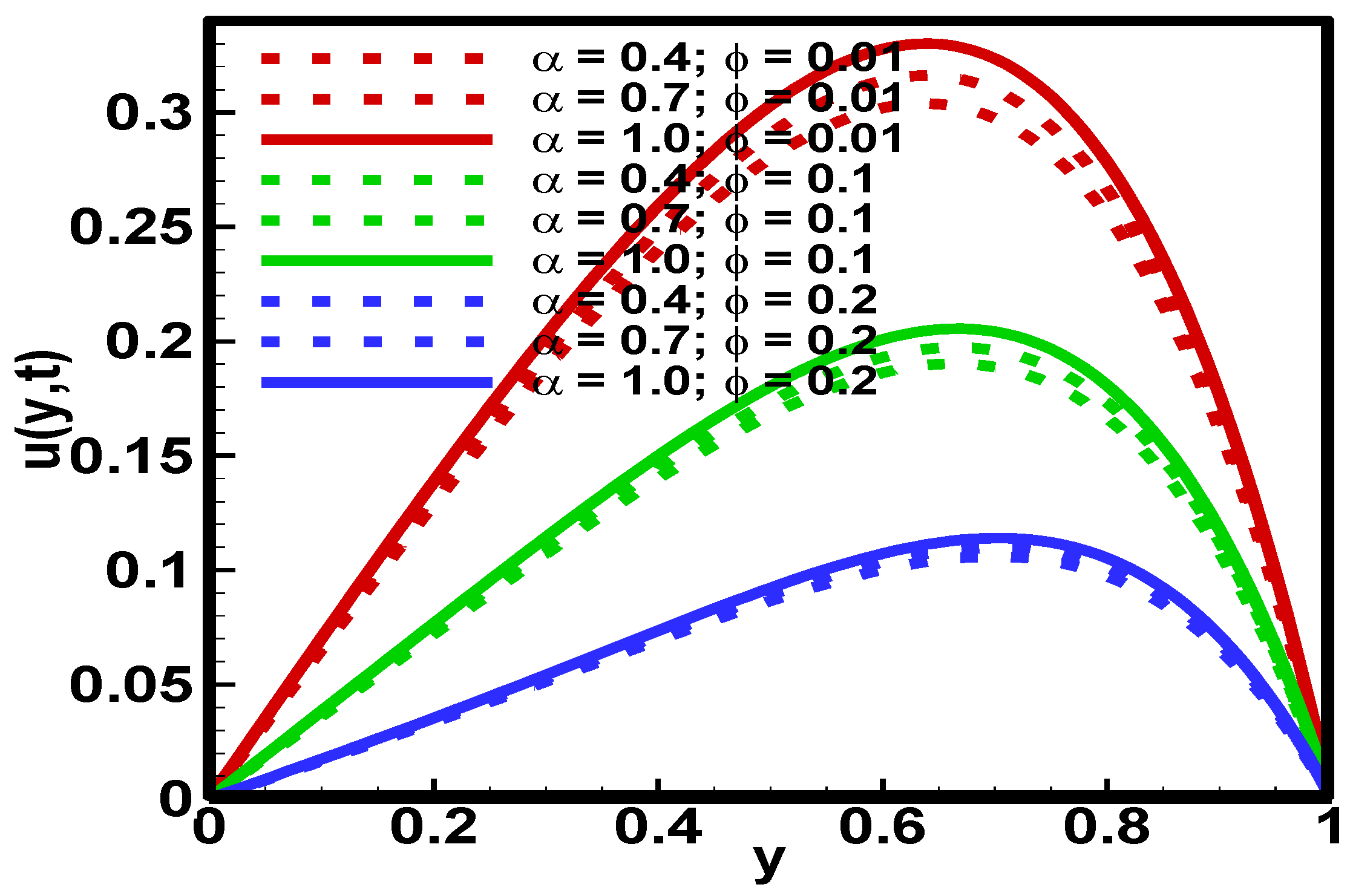
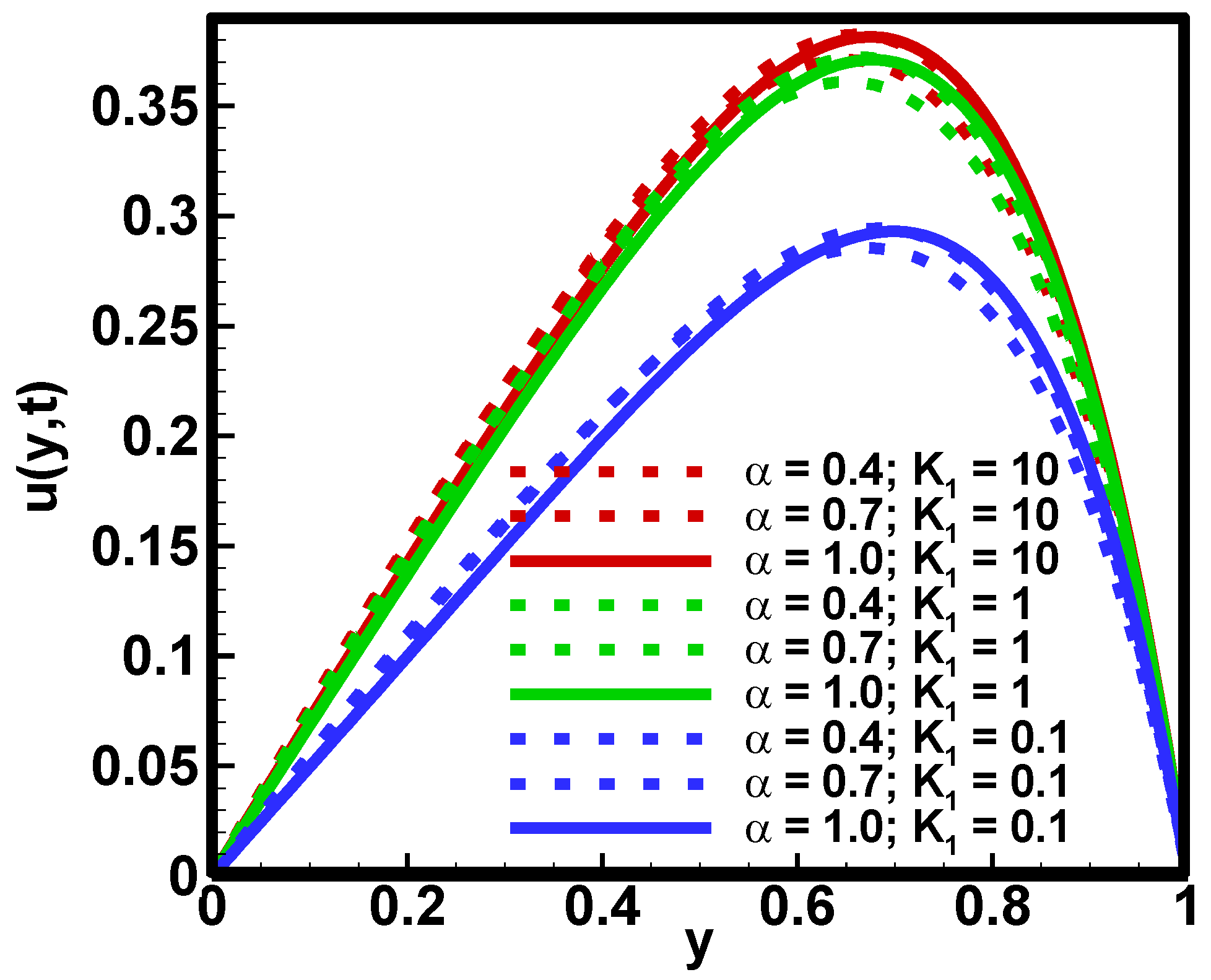
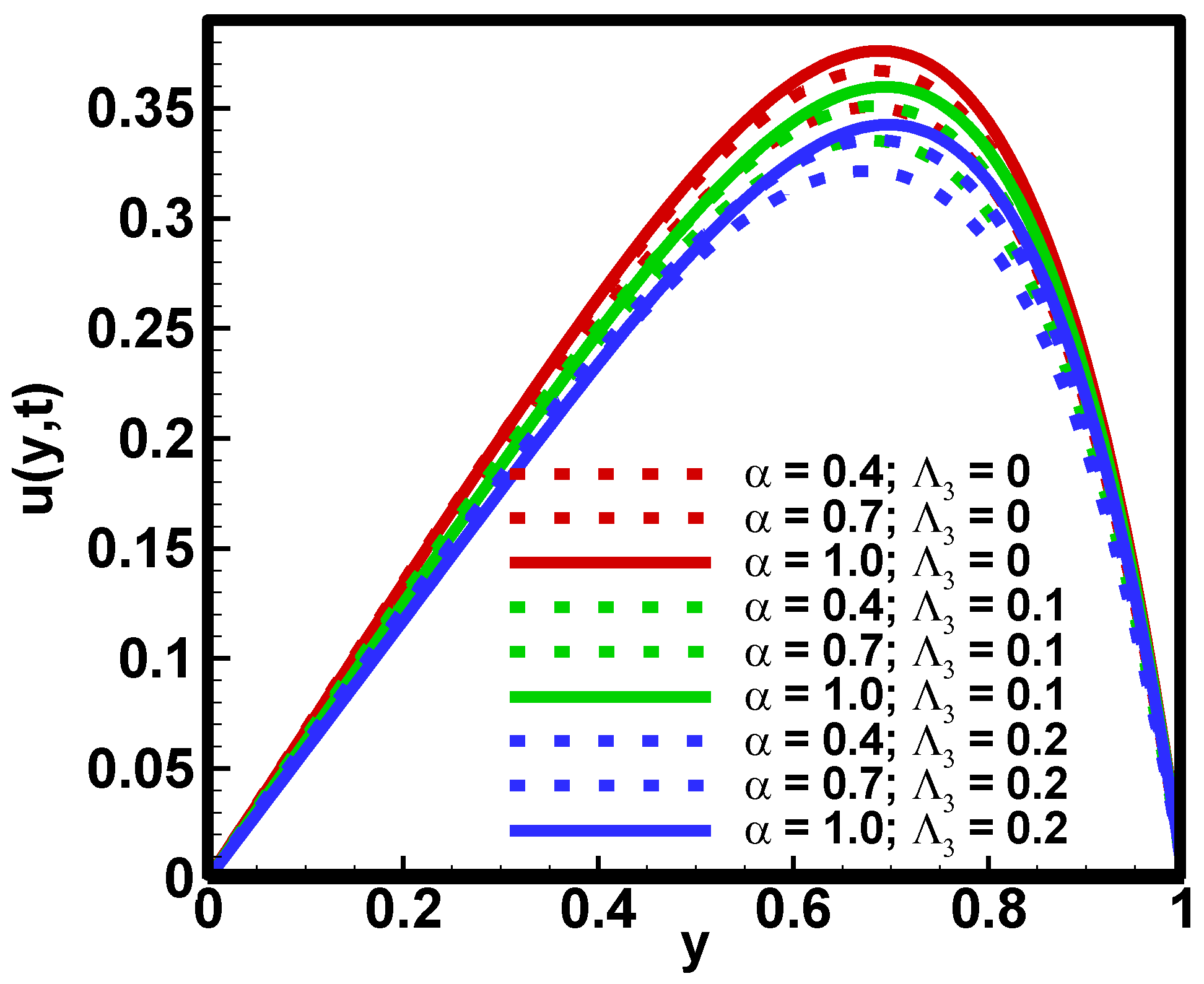
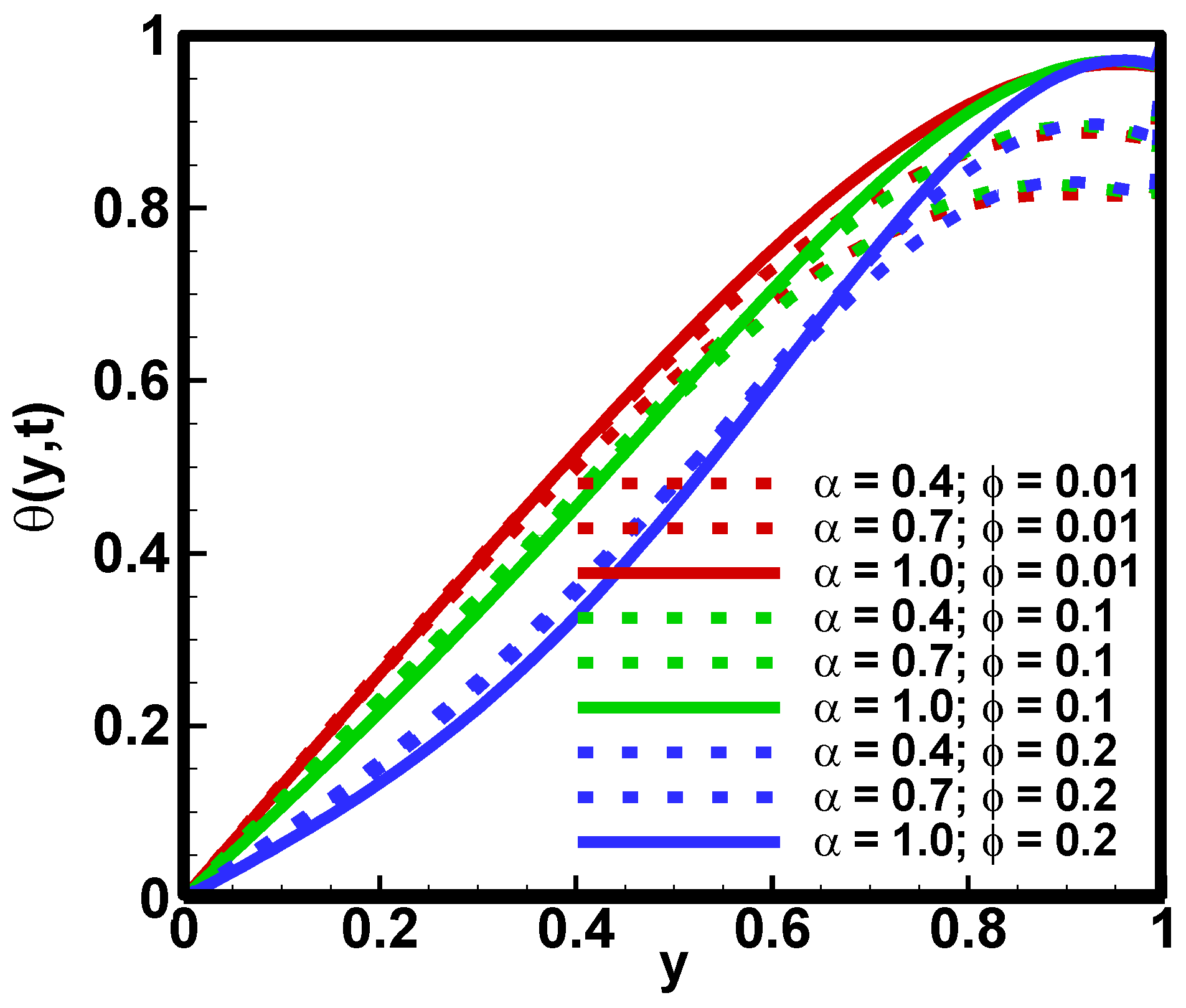

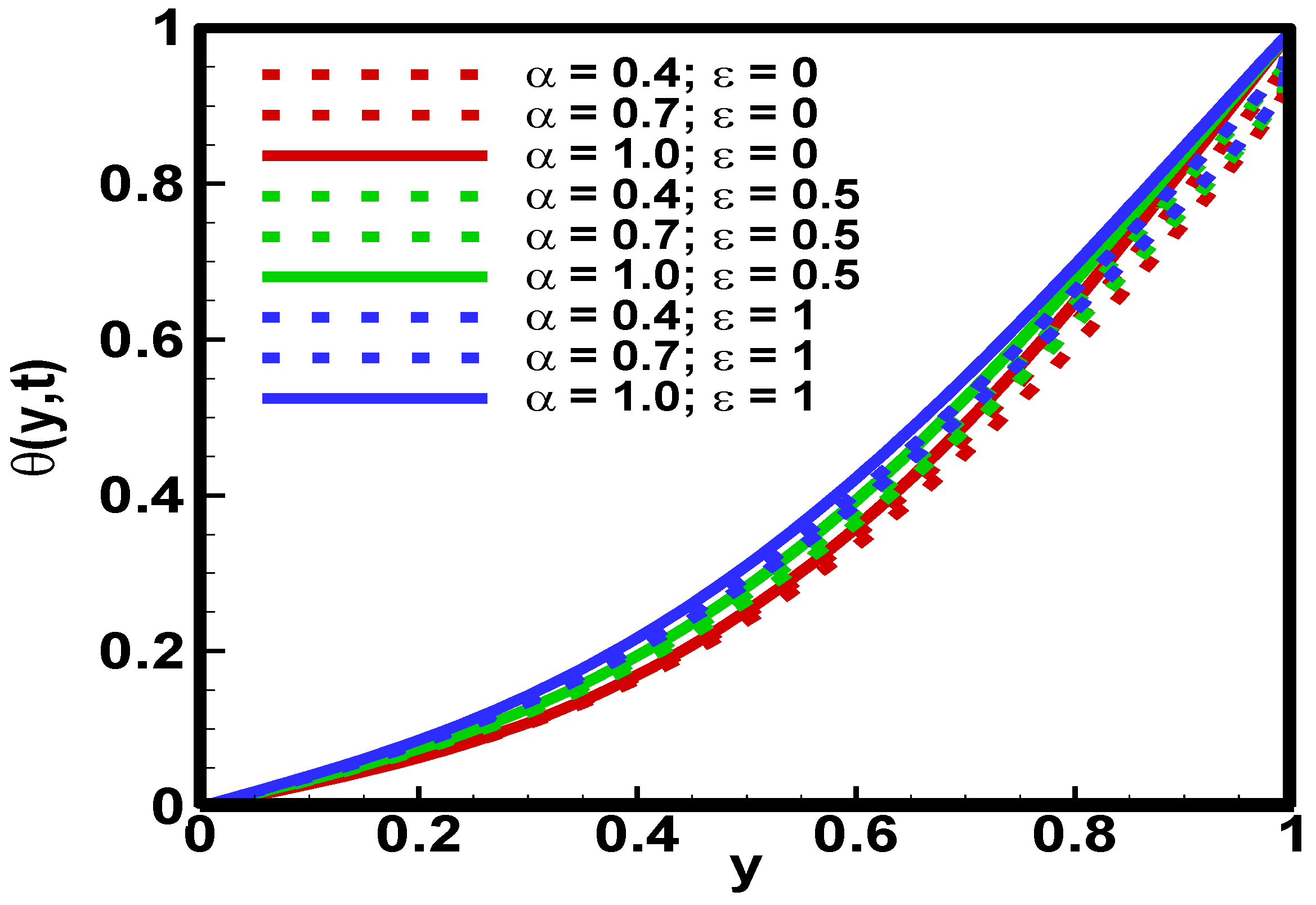

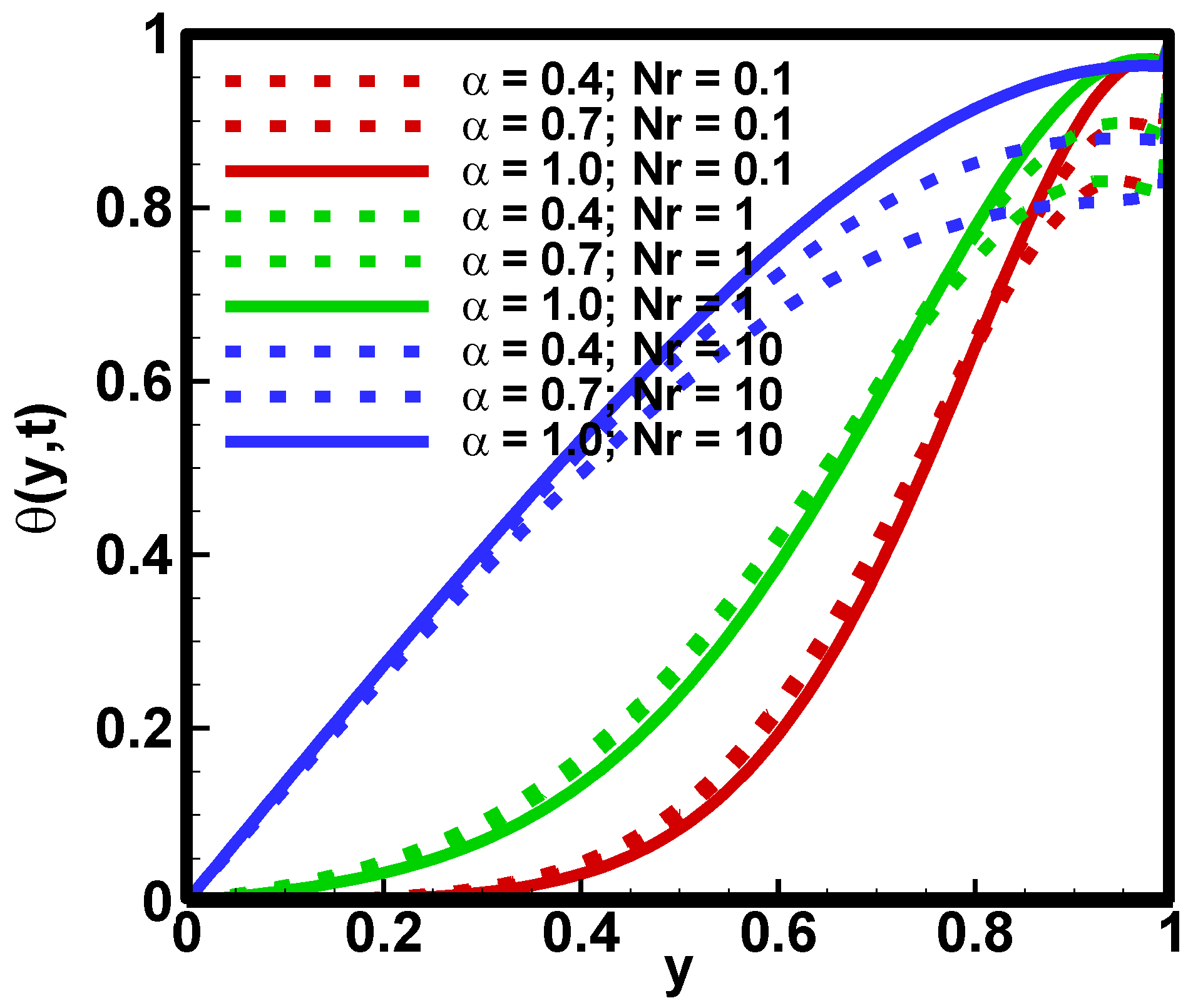

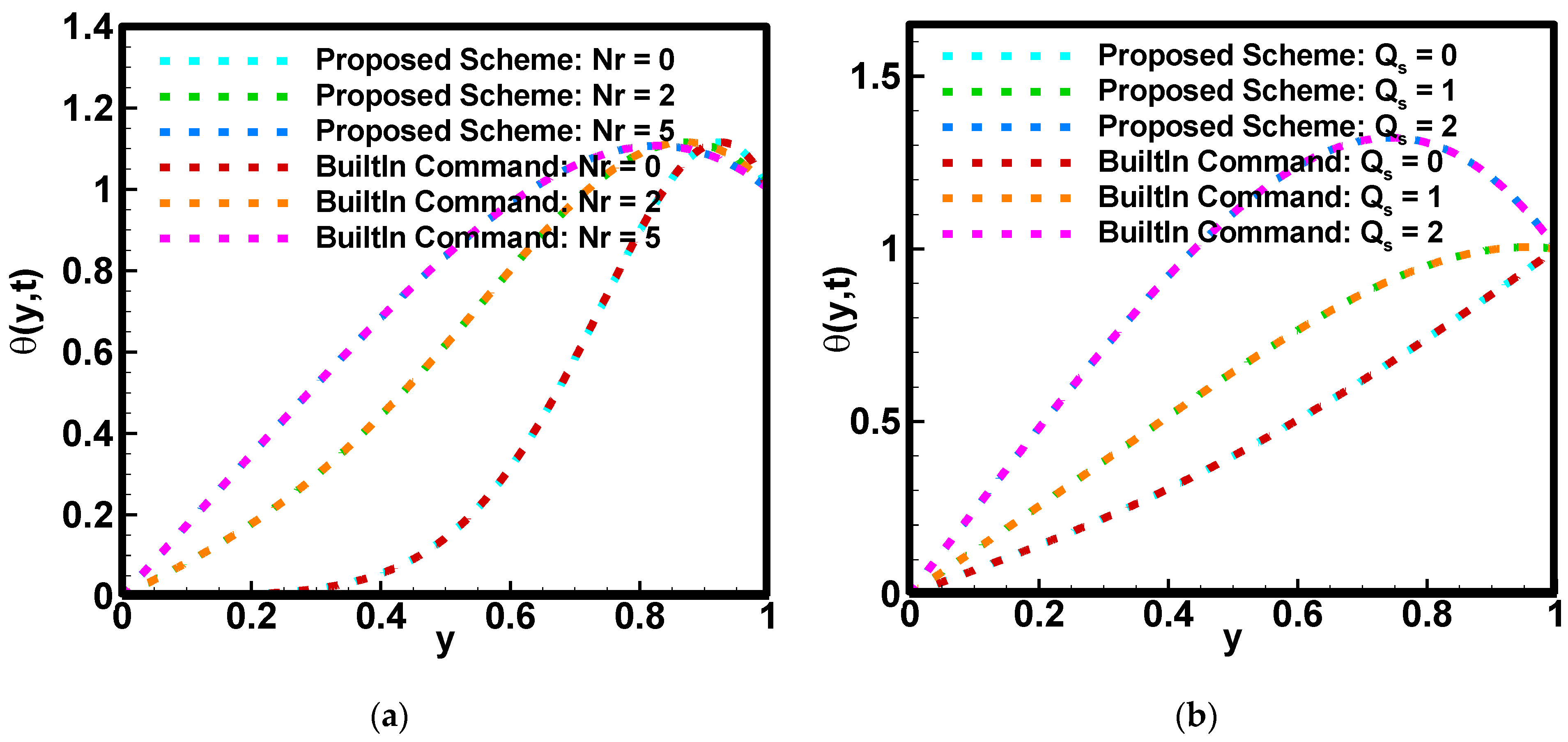
| Material | Base Fluid (Blood) | Nanoparticle (Copper) |
|---|---|---|
| 1053 | 8933 | |
| 3594 | 385 | |
| 0.492 | 401 | |
| 0.8 | 1.67 | |
| 0.18 | ||
| Pr | 21 | - |
| Ha | Gr | |||||||
|---|---|---|---|---|---|---|---|---|
| 0.4 | 0.7 | 1 | ||||||
| 0.0 | 0.3 | 5 | 10 | 0.1 | 0.1 | 0.4980 | 0.4721 | 0.4162 |
| 0.1 | 0.5270 | 0.5073 | 0.4579 | |||||
| 0.2 | 0.5527 | 0.5387 | 0.4959 | |||||
| 0.2 | 0.0 | 0.6633 | 0.6771 | 0.6686 | ||||
| 0.1 | 0.6377 | 0.6433 | 0.6224 | |||||
| 0.2 | 0.6140 | 0.6131 | 0.5835 | |||||
| 0 | 1.2025 | 1.1485 | 1.0248 | |||||
| 2 | 1.0207 | 0.9813 | 0.8841 | |||||
| 5 | 0.5527 | 0.5387 | 0.4959 | |||||
| 5 | 0 | 0.0553 | 0.0539 | 0.0496 | ||||
| 2 | 0.1105 | 0.1077 | 0.0992 | |||||
| 5 | 0.2764 | 0.2694 | 0.2479 | |||||
| 10 | 0.7679 | 0.7581 | 0.7125 | |||||
| 1 | 0.7422 | 0.7316 | 0.6862 | |||||
| 0.1 | 0.5527 | 0.5387 | 0.4959 | |||||
| 0.01 | 0.3454 | 0.3488 | 0.3355 | |||||
| 0.1 | 0.5527 | 0.5387 | 0.4959 | |||||
| 0.2 | 0.4959 | 0.4661 | 0.4111 | |||||
| Nr | |||||
|---|---|---|---|---|---|
| 0.4 | 0.7 | 1 | |||
| 0.0 | 5 | 1.5 | 2.6285 | 2.6285 | 2.6285 |
| 0.1 | 2.1938 | 2.2232 | 2.2236 | ||
| 0.2 | 1.9283 | 1.9324 | 1.8666 | ||
| 0.2 | 0.1 | 0.0164 | 0.0130 | 0.0090 | |
| 1 | 0.2633 | 0.2276 | 0.1770 | ||
| 10 | 1.9608 | 2.0404 | 2.0565 | ||
| 5 | 0 | 0.2614 | 0.2650 | 0.2564 | |
| 1 | 0.4245 | 0.4196 | 0.3932 | ||
| 2 | 0.7304 | 0.7011 | 0.6333 | ||
Publisher’s Note: MDPI stays neutral with regard to jurisdictional claims in published maps and institutional affiliations. |
© 2022 by the authors. Licensee MDPI, Basel, Switzerland. This article is an open access article distributed under the terms and conditions of the Creative Commons Attribution (CC BY) license (https://creativecommons.org/licenses/by/4.0/).
Share and Cite
Kaleem, M.M.; Usman, M.; Asjad, M.I.; Eldin, S.M. Magnetic Field, Variable Thermal Conductivity, Thermal Radiation, and Viscous Dissipation Effect on Heat and Momentum of Fractional Oldroyd-B Bio Nano-Fluid within a Channel. Fractal Fract. 2022, 6, 712. https://doi.org/10.3390/fractalfract6120712
Kaleem MM, Usman M, Asjad MI, Eldin SM. Magnetic Field, Variable Thermal Conductivity, Thermal Radiation, and Viscous Dissipation Effect on Heat and Momentum of Fractional Oldroyd-B Bio Nano-Fluid within a Channel. Fractal and Fractional. 2022; 6(12):712. https://doi.org/10.3390/fractalfract6120712
Chicago/Turabian StyleKaleem, Muhammad Madssar, Muhammad Usman, Muhammad Imran Asjad, and Sayed M. Eldin. 2022. "Magnetic Field, Variable Thermal Conductivity, Thermal Radiation, and Viscous Dissipation Effect on Heat and Momentum of Fractional Oldroyd-B Bio Nano-Fluid within a Channel" Fractal and Fractional 6, no. 12: 712. https://doi.org/10.3390/fractalfract6120712
APA StyleKaleem, M. M., Usman, M., Asjad, M. I., & Eldin, S. M. (2022). Magnetic Field, Variable Thermal Conductivity, Thermal Radiation, and Viscous Dissipation Effect on Heat and Momentum of Fractional Oldroyd-B Bio Nano-Fluid within a Channel. Fractal and Fractional, 6(12), 712. https://doi.org/10.3390/fractalfract6120712







